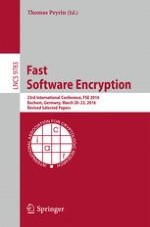This book constitutes the thoroughly refereed post-conference proceedings of the 23rd International Conference on Fast Software Encryption, held in Bochum, Germany, in March 2016. The 29 revised full papers presented were carefully reviewed and selected from 86 initial submissions. The papers are organized in topical sections on operating modes; stream-cipher cryptanalysis; components; side-channels and implementations; automated tools for cryptanalysis; designs; block-cipher cryptanalysis; foundations and theory; and authenticated-encryption and hash function cryptanalysis.
